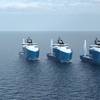Statoil said savings in acid-rain-causing nitrogen oxide (NOx) from two new low-emitting ships would allow it to meet its NOx emissions reduction targets from one new power station. "We've been given permission to credit these NOx reductions against land-based projects," Knut Barland, vice-president for environment at Statoil said. "And the kind of reduction we'd be getting on these ships would meet the NOx emission reduction target for one of these (planned) power plants."
The North Sea supply ships are small compared to cargo ships, but are so powerful they can be used to drag around oil rigs. They are usually so thirsty for diesel that they pump out as much NOx pollution each day as several thousand cars.
But by designing each of them to run on Liquified Natural Gas (LNG), gas that has been super-cooled until it condenses as liquid, NOx emissions from the two ships can be cut by 85 percent or 420 tons a year.
"That means one ship is equivalent to half the (NOx) emissions from a gas-fired power station," said Aksel Skjervheim of Naturgass Vest, which will provide the ships with their super-cooled fuel.
Statoil's Barland said that the government had given it a unique permission to credit the NOx reduction against land-based emissions, which could be from any one of five projects including two controversial 400 MW gas-fired power stations Statoil is involved in.
He said the power plants, one at Kaarstoe and one at Kollsnes near Bergen, were planned by a joint venture between Statoil, Norsk Hydro and Statkraft. They are not controversial because of their NOx emissions, but because of their carbon dioxide (CO2) emissions.
"We've been granted permission for the CO2 as long as we comply with Kyoto, but keeping the NOx down to the five parts per million (ppm) limit (specified by the government) could be very expensive," said Barland. Norway imposes a five ppm limit on NOx emissions in some regions aimed at curbing acid rain.
"Constructing a NOx treatment plant would be a very expensive and very old-fashioned way, and therefore we've been given the opportunity of finding a third party solution," he said.
The shipping NOx offset deal works out comparatively cheaply.
The two hi-specification ships will cost Statoil an extra nine million Norwegian crowns per year to run, compared to conventional diesel-powered ships. But when converted into NOx credits, they would allow Statoil to cut emissions at a cost of 22 crowns per kilogram (kg), compared to 30-40 crowns per kg by building NOx treatment into a new power plant.
While this approach to emissions might help overcome the NOx hurdle for the Kaarstoe and Kollsnes plants, the project might yet stumble on CO2 limits. "We could buy CO2 emissions permits, but there's still a lot of political uncertainty over the cost and that is something we're having to consider very carefully," said Barland.
He said much would depend on Kyoto's final mechanism for CO2 emissions trading and the extent to which Norway adopted the measures. Barland said he hoped the cost of future LNG-powered ships would fall as more LNG filling-stations were built around Norway's coast, and shipyards gained the right expertise.
To date only one LNG-powered ship has been built, a Norwegian fjord ferry, which runs on fuel from Norway's only LNG filling station, the Aga-owned 15,000 ton per year (tpy) mini-LNG plant at Tjeldbergodden.
Naturgass Vest, in which Statoil is a partner, hopes to build Norway's second mini-LNG plant of 30-40,000 tpy at Kollsnes and later on another near Stavanger. "That will make LNG-powered coastal shipping possible in Norway," said Barland. "Next time we issue a contract, we hope LNG will be competitive in its own right." - (Reuters)
Featured videos

Inside the Electrified Truckable Tug

Inmarsat Enhances Service to Drive Digitalization

Tracking Foreign Vessels Working in the U.S. Jones Act Market
Subscribe for
Maritime Reporter E-News
Maritime Reporter E-News is the maritime industry's largest circulation and most authoritative ENews Service, delivered to your Email five times per week









